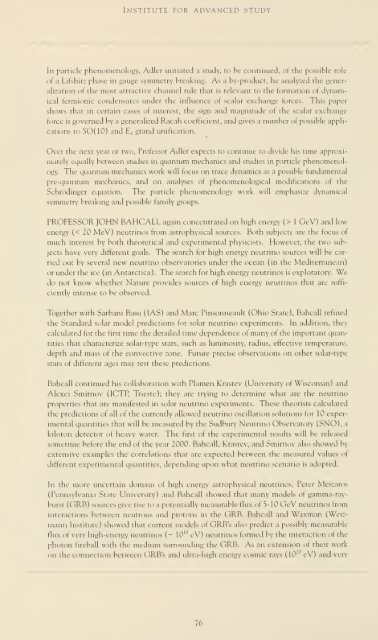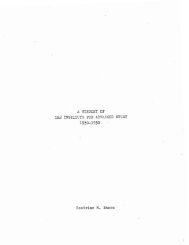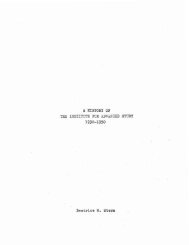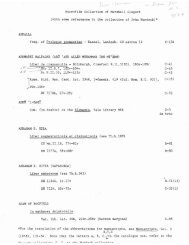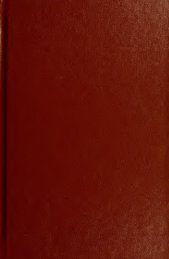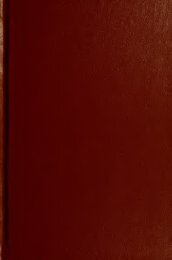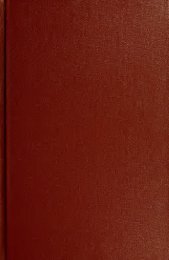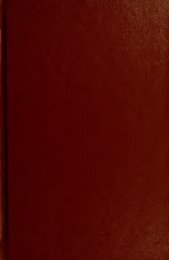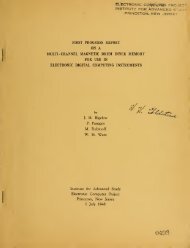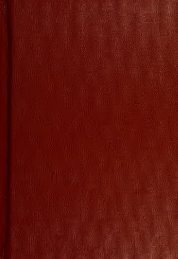Report for the academic year - Libraries - Institute for Advanced Study
Report for the academic year - Libraries - Institute for Advanced Study
Report for the academic year - Libraries - Institute for Advanced Study
You also want an ePaper? Increase the reach of your titles
YUMPU automatically turns print PDFs into web optimized ePapers that Google loves.
<strong>Institute</strong> <strong>for</strong> advanced study<br />
In partic l( pheni imenology, Adlcr initiated a study, to be continued, of <strong>the</strong> possible role<br />
of al ifshitt phase in gauge symmetry breaking. As a by-product, he analyzed <strong>the</strong> gener-<br />
alization of <strong>the</strong> most attractive channel rule that is relevant to <strong>the</strong> <strong>for</strong>mation of dynam-<br />
ical fermionic condensates under <strong>the</strong> influence of scalar exchange <strong>for</strong>ces. This piper<br />
shows that in certain cases ot intrust, <strong>the</strong> sign and magnitude ol <strong>the</strong> scalar exchange<br />
<strong>for</strong>ce is governed by a generalized Racah coefficient, and gives a number of possible appli-<br />
cations to S( H 10) and E„ grand unification.<br />
Over <strong>the</strong> next <strong>year</strong> or two, Professor Adlcr expects to continue to divide his time approxi-<br />
mately equally between studies in quantum mechanics and studies in particle phenomenol-<br />
ogy. The quantum mechanics work will focus on trace dynamics as a possible fundamental<br />
pre-quantum mechanics, and on analyses of phenomenological modifications of <strong>the</strong><br />
Schrodingei equation. The particle phenomenology work will emphasize dynamical<br />
symmetry breaking and possible family groups.<br />
PROFESSOR JOHN BAHCALL again concentrated on high energy (> 1 GeV) and low<br />
energy (< 20 MeV) neutrinos from astrophysical sources. Both subjects are <strong>the</strong> focus of<br />
much interest by both <strong>the</strong>oretical and experimental physicists. However, <strong>the</strong> two sub-<br />
jects have very different goals. The search <strong>for</strong> high energy neutrino sources will be car-<br />
ried out by several new neutrino observatories under <strong>the</strong> ocean (in <strong>the</strong> Mediterranean)<br />
or under <strong>the</strong> ice (in Antarctica). The search <strong>for</strong> high energy neutrinos is exploratory. We<br />
do not know whe<strong>the</strong>r Nature provides sources of high energy neutrinos that are suffi-<br />
^ iently intense to be observed.<br />
Toge<strong>the</strong>r with Sarbani Basu (IAS) and Marc Pinsonneault (Ohio State), Bahcall refined<br />
<strong>the</strong> Standard solar model predictions <strong>for</strong> solar neutrino experiments. In addition, <strong>the</strong>y<br />
calculated <strong>for</strong> <strong>the</strong> first time <strong>the</strong> detailed time dependence of many of <strong>the</strong> important quan-<br />
tities that characterize solar-type stars, such as luminosity, radius, effective temperature,<br />
depth and mass of <strong>the</strong> convective zone. Future precise observations on o<strong>the</strong>r solar-type<br />
stars ot different ages may test <strong>the</strong>se predictions.<br />
Bahcall continued his collaboration with Plamen Krastev (University of Wisconsin) and<br />
Alexei Smirnov (ICrTP, Trieste); <strong>the</strong>y are trying to determine what are <strong>the</strong> neutrino<br />
properties that are manifested in solar neutrino experiments. These <strong>the</strong>orists calculated<br />
<strong>the</strong> predictions of all of <strong>the</strong> currently allowed neutrino oscillation solutions <strong>for</strong> 10 exper-<br />
imental quantities that will be measured by <strong>the</strong> Sudbury Neutrino Observatory (SNO), a<br />
kiloton detector ot heavy water. The firsl ol <strong>the</strong> experimental results will be released<br />
s timebefon <strong>the</strong> end d <strong>the</strong> <strong>year</strong> 2000. Bahcall, Krastev, and Smirnov also showed K<br />
extensive examples <strong>the</strong> correlations that are expected between <strong>the</strong> measured values ot<br />
different experimental quantities, depending upon what neutrino scenario is adopted.<br />
In <strong>the</strong> more uncertain domain ol high energy astrophysical neutrinos, Peter Meszaros<br />
(Pennsylvania State University) and Bahcall showed thai many models oi gamma ray<br />
I -in si (< IRB) sources give rise to a potentially measurable flux of 5-10 ( ie\ neutrinos from<br />
interactions between neutrons and protons in <strong>the</strong> GRB, Bahcall and W'axman (Weu<br />
m. inn <strong>Institute</strong>) showed that current models of GRB's also predict a possibly measurable<br />
flux ot wry high-energy neutrinos ( 10 U eV) neutrinos <strong>for</strong>med by <strong>the</strong> interaction ol <strong>the</strong><br />
photon fireball with <strong>the</strong> medium surrounding <strong>the</strong> GRB. As an extension of <strong>the</strong>ir work<br />
on <strong>the</strong> connection between t IRB's and ultra-high energy cosmic rays (10 eV) and very<br />
76


